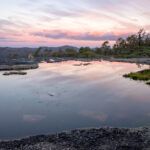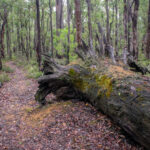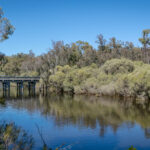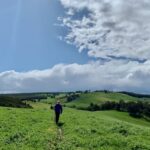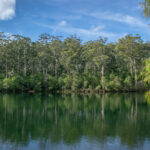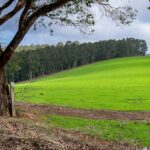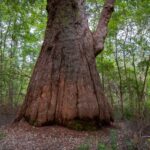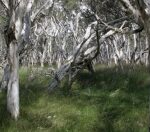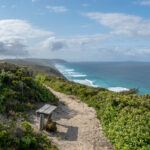Health, Hygiene & Safety
These notes will help to make your Bibbulmun Track experience safer and more enjoyable.
All walkers should read the information about staying safe in parks at Explore Parks WA.
We also recommend that walkers download the Emergency + app onto their smart phone. The app is free and available for download on iOS, Android and Windows devices. The app will give the location coordinates which can then be communicated to emergency services if you have phone reception for a phone call or SMS. Click here for more information.
Walking in summer
It is strongly recommended that you do not carry out any extended walk between December and the start of March anywhere on the Track.
The Track gets very hot and the bushfire risk is extreme. Temperatures can range from low 30s to mid-40s. In recent years the Track has been severely impacted by bushfires with the destruction of campsites and other structures which fire fighters were not able to save due to the ferocity of the fires. Much of the Track is difficult to access quickly in an emergency and more so during a bushfire.
Please plan to walk outside of these months and avoid putting your life at risk and the lives of those that may need to rescue you.
Day walks in the karri forest can be comfortable on cooler days (temperatures less than 27 degrees). We advise people planning a day walk to check the weather and fire forecasts. If the fire danger is ‘very high’ or above we strongly recommend people don’t go out on the Track, or leave if they are already out. If in doubt, and the weather forecast is for hot and windy conditions, our recommendation is not to go walking. The south coast, although may be cooler, offers little protection from the sun due to the lack of a forest canopy and fire spreads more quickly in open bush and grassland.
See the section on bushfires below.
Use of tents, free camping and tent sites
All the Bibbulmun Track campsites have tent sites around or near the shelters. There is no booking system for the shelters and it is recommended that tents be carried, as space in a shelter cannot be guaranteed. All walkers who intend to stay overnight in a shelter on the Track should carry a tent, in case the shelter is full on arrival or you wish to be warmer at night, be away from snorers and protected from mosquitos and other bugs. Importantly, when a campsite is closed, for example during a prescribed burn, temporary campsites do not have shelters and tents are essential. Groups of more than eight people are not permitted to occupy a shelter until after 6pm. Tents must be pitched in the sites provided at the campsites. The Bibbulmun Track Foundation offers walkers a tent hire service.
No camping (free camping) is permitted between Bibbulmun Track campsites, where there is no official designated campsite, in National Parks, Conservation Parks or Nature Reserves. This also applies to water catchment areas – ie most of the Track between Kalamunda and Collie, and south of the Blackwood River.

Each campsite has a pit toilet.
Waste
Toilet facilities at the campsites are to be used when available. Where no toilet facility is available, waste and toilet paper must be buried 15cm deep and must be at least 100 metres from any body of water. Minimum impact bush walking and Leave No Trace camping principles must be adhered to by all. No food, litter, nappies or sanitary items are to be put in the toilet, buried or left at the campsite, on the Track or in the bush. This includes organic items such as apple cores and fruit peel. Leave nothing but footprints!
Campfires, bushfires and prescribed burns

Campfires are a tradition in Australian bush walking. However, the environment is becoming less and less tolerant of campfires, particularly in the surrounds of the Bibbulmun Track campsites. Many campsites have been stripped bare of firewood due to the continual use of fires. Fires, if lit at all, should be kept to a minimal size. There is no point in having a raging fire when a small one provides more than enough warmth. Remember the old Aboriginal saying: The white person makes a big fire and has to sit far away – the black person makes a small fire and sits close. Campfires may be lit only at approved campsites. The Blackwood and Yourdamung campsites and all the campsites between Albany and the Shannon River are designated as no fire zones all year round. They do not have fireplaces, and in these campsites, fuel stoves only must be used.
See also: fires at campsites and also bushfire information and bushfire safety produced by the Parks and Wildlife Service.
All walkers must take care with fire. No one is permitted to light a fire on days of very high or extreme fire danger. Under these circumstances, operate a fuel stove only at the campsite. Under no circumstances should a fuel stove be used in or near a tent. Check the current fire conditions as fire bans usually exist between December and April each year. All fires must be totally extinguished before you leave a campsite.
This link is useful in helping to understand fire weather.
Prescribed burning is the process of planning and applying fire to a predetermined area, under specific environmental conditions, to achieve a desired outcome. Prescribed, controlled and planned burns are the same thing. In Western Australia, they are referred to as prescribed burns because they follow a ‘prescription’ with a number of conditions that need to be met. For more information on prescribed burns conducted by Parks and Wildlife please click here.
If a prescribed burn is impacting upon the Track it will be listed in the Track conditions. Please visit the Section By Section Guide and select the relevant section you are walking in and click on the realignments and diversions tab.
Water
Water should be treated with respect. Water tanks at campsites are not filled other than by rainfall and the water must last through long dry spells. Untreated water may contain micro-organisms and particles, which can cause diseases such as gastro enteritis. Drink only treated water – this includes treating water taken from the campsite water tanks. Do not assume that creeks or watercourses indicated on the maps actually have water in them. Most are ephemeral and run only in peak rain periods, and then only very briefly.
Detergents

Everyday soaps and detergents should not be used in the Australian bush. They are harmful to its biodiversity. Biodegradable toothpaste should be considered, and sanitizing gels that require no water and leave no waste are a must. They can be purchased at most supermarkets, outdoor equipment stores and pharmacies. Walkers should not bring everyday soaps, detergents or shampoo to use in the bush.
Water catchments
The Bibbulmun Track passes through 12 harnessed water catchments between Kalamunda and Collie and even more further south. The supply of clean water is crucial. All walkers must observe rules and regulations designed to protect our water supplies. Free camping (camping away from designated campsites) is not permitted in water catchments.
Pests and risks to health
March flies can be a problem in the drier, warmer months. They will give a painful bite and are particularly attracted to the colour blue. At dawn and dusk, mosquitoes and midges are most active. Ross River virus is a debilitating illness which can be transmitted by mosquito bites. It is most prevalent in the warmer, summer months anywhere where mosquitoes are likely to be found, such as near water courses and any swampy areas. It is most important to protect the skin at these times by using insect repellent and covering up. Summer walkers often carry a mosquito net to set up inside campsite shelters to if not using a tent protect against mosquitoes. Please however ensure that your net does not impact upon other walkers using the shelter. It is always better to carry and use a tent.
Venomous snakes can also be encountered almost anywhere along the Track, particularly in spring. Always keep in mind always that snakes are more afraid of you than you are of them. Normally they will sense the thumping of your footfalls and make a hasty retreat well before you can see them. An exception to this can be on unseasonably warm days in late winter and spring when any snakes, which curl up for a long sleep during cold weather, will be sluggish if they are around. In this state they are more likely to feel threatened and, if encountered, the walker should steer well clear of them. Tiger snakes, which are highly venomous, are fairly common near swamps, wetlands and karri forest while dugites occur in drier areas anywhere. See snake descriptions under ‘Fauna’ in this Guide.
Most bites occur on the ankle or lower leg, so wearing gaiters, thick socks and sturdy boots will help prevent snake bites. In the event of a snakebite see first aid tips below.
Blister bush: Where the Track goes near the margins of creeks and swamps near coastal areas walkers are likely to encounter blister bush (Phebalium anceps). This is a slender shrub with bright, light green leaves 4 – 12cm long, which are covered with fine, silvery scales when young. Mainly between August and November it has small clusters of small white flowers along the stems. Contact with any part of this plant can cause blistering of the skin to a small percentage of walkers. It should not pose any problems as it is easy to avoid.
Kangaroo and pepper ticks can easily find their way from bushes onto your body when you brush past them. They are particularly common from October to early autumn on the northern parts of the Track. Carefully check your body regularly, especially creases, as they can go undetected for some time and can cause irritation in some people. If they have buried their heads into your skin, the best remedy to remove them is to use fine pointed tweezers to carefully remove the tick, ensuring the head is not left beneath the skin. Tea tree oil will greatly help reduce itching. Lymes Disease, common in USA and Europe and carried by ticks, is unknown in Western Australia.
Sandflies can be a problem for people who are sensitive to their bite and can occur anywhere. They are very small, grey flies. Their bite is not immediately detected but within a few hours or a day of being bitten small, red, very itchy marks may develop on the skin at the bite sites. It is not uncommon for sensitive people to have dozens of bites that can be very itchy and take up to a week to settle down. Insect repellant, covering up and avoiding sitting on the ground in the bush appear to help. Tea tree oil will greatly help reduce itching.
Wild pigs do inhabit the forests, but are rarely seen. You are advised to not approach them. Feral foxes and cats may also be seen, but pose no threat to humans.
Bees are often attracted to the campsite rainwater tank and tap, especially in the drier months. Bees are also prevalent in the spring with the onset of the wildflower season. If you are allergic to bee stings, then ensure you carry the appropriate medication.
Walkers should be aware that some campsites have a problem with mice. Some also have resident marsupials or native mice which will look for food at dusk and during the night. Hang food (and rubbish) from rafters, away from walls and uprights, or put it in your tent while you are in there.
First aid

The following information should only be used as a guideline and should not replace your first aid training! There are many courses available to the public, but we suggest that a wilderness first aid course is more appropriate. You should also carry an appropriate first aid kit.
Avoiding snake bite
Tips from Bob Cooper, our own expert in reptiles and outback survival and Sea to Summit.
- Do not approach a snake: it doesn’t know what your intention is, and that you are just observing or trying to help.
- You can make a snake very scared by pointing and waving your arms in the air above the snake, so instead, keep your movements calm and slow. Also, don’t raise your feet up in front of the snake – that will provoke a strike.
- Wear closed-in footwear at all times when bushwalking and preferably wear long trousers and/or gaiters.
- Use a dead stick or trekking pole to probe long grass as you walk through, as this will encourage the snake to move out of your path.
- Do not cast a shadow onto a snake as that will make it nervous.
- Most bites occur on the ankle or lower leg, so wearing gaiters will help prevent snake bites. Wear ankle to knee gaiters. There are 30 species of snakes in Australia that are considered to have life-threatening venom. Fortunately these belong to one group of snakes known as elapids, meaning they have fixed front fangs. The average length would be 4-6mm on a metre long snake and up to 12mm on a very large snake. These relatively small fangs means that by wearing gaiters you can greatly decrease the chance of a snake successfully piercing you skin. Gaiters will help prevent a bite, but can never offer 100% protection against snake bites.
- For more information on gaiters, see Sea to Summit and search Gaiters.
Snake bite treatment
- Always keep your snake bite kit handy in your pack. Three bandage rolls are recommended.
- Keep the patient calm and completely at rest.
- Set off your PLB or equivalent emergency beacon as soon as practicable or call 000 if you have a phone signal. Use the Emergency + App to determine your GPS location. Always have help come to the patient. Do not try to walk the patient to help.
- Immediately apply pressure directly on to the bite. You must remove all clothing and/or footwear. If you cannot get down to skin level, applying pressure may not be as effective as it should be. Get a visual on the bite.
- If the victim is bitten on a limb, apply a firm compression bandage from just below the knee or elbow with the first bandage and down to the toes or fingers (but without covering them). Use the second bandage if needed to complete this.
- With the second bandage (or the third bandage if the second has already been used), start at the same point as the first bandage and work your way up to the groin or armpit.
- The bandage should be firm but not tight – blood supply should not be cut off. Check circulation by squeezing the toes or fingers. They should return to normal skin colour within three to four seconds after squeezing showing that the blood supply has not been cut off. If blood supply has been cut off, then you need to remove the bandages and start again.
- Mark the site of the bite on the bandage by a circle and also write the time of the bite on the bandage.
- The limb should be immobilised with a splint or sling so they cannot move it. Even something simple as tying the ankles together will stop any attempt to walk.
- Once applied, the bandage should remain in place until medical care arrives (try to bring transport as near as possible to the patient). Never remove the bandage. Trained medical personnel will do this.
- Do not wash the venom off the skin, as this will assist in the identification of the snake.
- Do not attempt to catch the snake. You will probably be bitten as well.
- Do not elevate the affected limb.
- Do not apply a tourniquet.
- Always assume that a bite contains venom. While it is true that snakes preserve their venom to kill prey (rather than use it in defence), it is near impossible when out on the Track to determine if the bite contains venom or is a dry bite.
- Watch a video on treating snake bite.
Bee stings
- The barb from a sting should be removed if it remains in the flesh.
- Remove the barb by brushing or scraping sideways; never pull the sting out as it will inject more venom.
- Raise the affected part and apply a cool compress or chemical ice to reduce swelling.
- Anyone who has an allergic reaction should also be treated as for a snake bite (see above).
Heat exhaustion and dehydration
Exposure to hot and humid weather may lead to these conditions as a result of normal body cooling processes becoming inefficient. The person may feel hot, faint, giddy, thirsty, complain of nausea, cramps, headache, and will appear clammy with excessive sweating, rapid breathing and have a rapid pulse rate.
- Assist the person to rest in shade.
- Sponge exposed skin with cool water.
- Ensure the person drinks plenty of cool water preferably mixed with electrolytes.
Sprains and strains
Sprains occur when a ligament around a joint is over-stretched or torn, or when a muscle or tendon is over-stretched or torn. Similar aid is required in both cases.
- Assist the person to be comfortable.
- Raise the injured part to reduce swelling.
- Support the injury with a firm bandage, and apply a cool compress over the bandage for 10 minutes.
- Rest the injury for up to 48 hours.

Ticks
- Current best practice is to remove the tick using an ether to freeze it. It will then fall out.
- Alternatively (or if it doesn’t fall out after freezing) grip the tick with special tick tweezers and gently twist it out, but it is imperative that the tweezers are applied as close to the skin as possible before closing them. Do not use household tweezers. Avoid squeezing the body of the tick as it may squeeze its saliva into the wound – a common problem with using household tweezers.
- Check the rest of the body, including hair, skin creases & ears.
- Other removal options include using a mixture of tea-tree and eucalyptus oils to kill it before removal.
Bleeding and wounds
- If too much blood is being lost from a wound or injury, stop the flow of blood by pressing firmly on the wound with a bulky sterile dressing.
- Keep firm pressure on the wound for 10 min with the person resting. If the wound is on a limb, elevate the limb.
- Comfort and reassurance will slow heartbeat and reduce further loss of blood.
- Minor wounds should be cleaned and dressed.
Please note that this information is only a guide to assist in emergencies on the Track – adequate preparation is also essential when planning a Bibbulmun walk. Be first aid trained!



